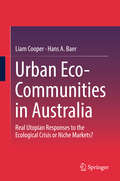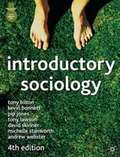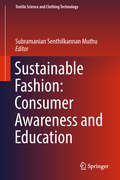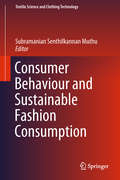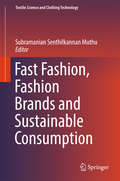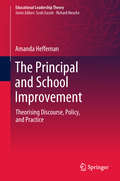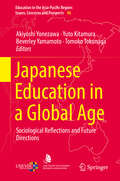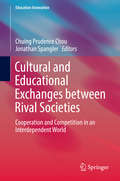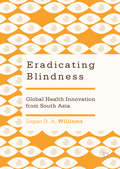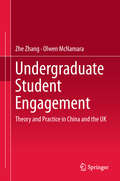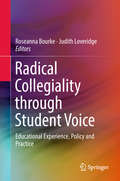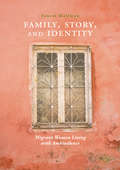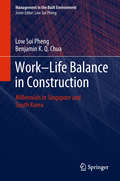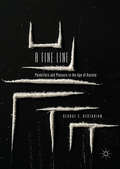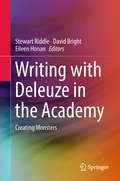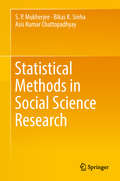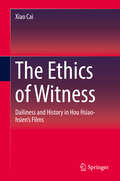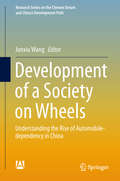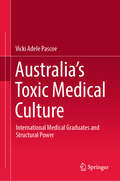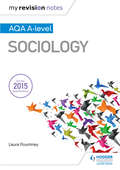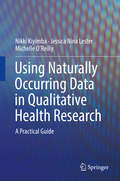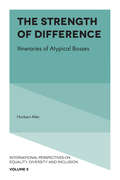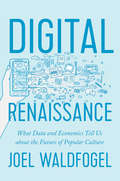- Table View
- List View
Urban Eco-Communities in Australia: Real Utopian Responses to the Ecological Crisis or Niche Markets?
by Liam Cooper Hans A. BaerThis book offers one of the first detailed anthropological studies of emergent ecotopianism in urban contexts. Engaging directly with debates on urbanisation, sustainability and utopia, it presents two detailed ethnographic case studies of inner urban Australian eco-communities in Adelaide and Melbourne. These novel responses to the ecological crisis – real social laboratories that attempt to manifest a vision of the ‘eco-city’ in microcosm – offer substantial new insights into the concept and creation of sustainable urban communities, their attempts to cultivate ways of living that are socially and ecologically nourishing, and their often fraught relationship to the capitalist city beyond. These studies also suggest the opportunities and limitations of moving beyond demonstration projects towards wider urban transformation, as well as exposing the problems of accessibility and affordability that thwart further urban eco-interventions and the ways that existing projects can exacerbate issues of gentrification and privilege in a socially polarised city. Amidst the challenges of the capitalist city, climate change and ecological crisis, this book offers vital lessons on the potential of urban sustainability in future cities.
Introductory Sociology (PDF)
by Tony Bilton Kevin Bonnett Pip JonesIntroductory Sociology is one of the most ambitious, scholarly and popular textbooks in its field. This welcome new edition builds on the strengths of its predecessor in its thematic coherence, clarity of exposition and analytical depth. It is carefully structured to cover all the main substantive topics studied at an introductory level within a framework that engages with exciting contemporary debates about modernity, globalisation and social identity. Key features of the new edition include: - a completely new chapter on the media - extended coverage of social divisions to include disability, youth and old age as well as class, gender and race - clearer and more compact treatment of social theory, incorporating discussion of work by such contemporary theorists as Habermas, Giddens and Beck - an even stronger blend of theoretical, empirical and illustrative material, consolidating the critical and applied approach that is one of the text's most well-liked defining features With outstanding presentation and pedagogical support for the student and hard-pressed lecturer alike, the text includes: - an Instructor's Resource Pack, complete with powerpoint slides, available on the Palgrave website (or in hardcopy for adopters of the textbook, by written request) - a detailed and extensive glossary - practically a 'mini dictionary' of sociology in its own right and an ideal reference tool - chapter-specific further reading lists, annotated for further guidance and support - questions to think about, which can be used as the basis for essays, class discussion and further study - pictures, figures, graphs and tables.
Sustainable Fashion: Consumer Awareness and Education (Textile Science and Clothing Technology)
by Subramanian Senthilkannan MuthuThis book uses case studies to discuss consumer awareness of and education on sustainable fashion. It highlights how some textile brands have started using consumer awareness tags to educate consumers on the use of their products (e.g. which machine cycle and temperature they should use to wash their products, as well as the best drying conditions in terms of environmental sustainability). Consumer awareness of and knowledge on sustainable fashion is the crux of customer-centric sustainability, and several NGOs and even brands have started taking essential steps to promote this.
Consumer Behaviour and Sustainable Fashion Consumption (Textile Science and Clothing Technology)
by Subramanian Senthilkannan MuthuThis book analyses the importance of consumer behaviour in sustainable fashion and consumption. Consumer behaviour plays a major role in sustainability, and when it comes to textile products, a number of studies have shown that for certain product categories, consumer behaviour during use and disposal stages influences the entire life cycle impacts of the product more than the raw material and manufacturing stages. However green the production, the overall sustainability of a product depends on the consumers who use and dispose of it.
Fast Fashion, Fashion Brands and Sustainable Consumption (Textile Science and Clothing Technology)
by Subramanian Senthilkannan MuthuThis book discusses the connection between fast fashion brands and customer-centric sustainability. It highlights what consumers can do with fast fashion and the important aspects that need to be addressed to make fast fashion sustainable. Fast fashion is an inevitable element in today’s fashion business cycle and its adverse impacts on sustainable fashion are a major issue.
The Principal and School Improvement: Theorising Discourse, Policy, and Practice (Educational Leadership Theory)
by Amanda HeffernanThis book investigates the localised effects of reform by exploring the impact of a school improvement policy agenda on the work of three experienced principals. It presents three longitudinal case studies within a shared specific leadership context in Queensland, Australia. The case studies enable an exploration of the way the principalship in this context has evolved over time, providing deep insights into the practices and beliefs of three experienced school leaders working in a period of rapid and urgent systemic reform. The nature of global reform policy borrowing means that the research and the findings within this monograph are relevant for international audiences.The book describes a new way to understand and theorise the effects of reform policies and associated pressures on school leaders. Using post-structural theory, it provides a better understanding of the specific effects of reform policy ensembles, particularly when combined with an analysis of the ways policy and discourse work together at a wider level to create an environment that disciplines the principalship. Further, it sheds lights on the means of complying with or contesting policy influences and how the work of leaders has changed over time.
Japanese Education in a Global Age: Sociological Reflections and Future Directions (Education in the Asia-Pacific Region: Issues, Concerns and Prospects #46)
by Akiyoshi Yonezawa Yuto Kitamura Beverley Yamamoto Tomoko TokunagaThis book highlights recent education research on Japan based on sociological and other related approaches to historical developments and accomplishments. Written primarily by members of the Japan Society of Educational Sociology, it brings to light concerns and viewpoints that have grown out of the Japanese educational context. By focusing on uniquely Japanese educational research phenomena, the book offers international readers new insights and contributes to the international debate on education. It may help sociologists and social scientists outside Japan gain a deeper understanding of ongoing changes in education in Japan as well as its historical and structural contexts.
Cultural and Educational Exchanges between Rival Societies: Cooperation and Competition in an Interdependent World (Education Innovation Series)
by Chuing Prudence Chou Jonathan SpanglerThis book stimulates discussions on cultural and educational exchanges between rival states and societies, raises awareness of the potential positive and negative impacts of such exchanges, and serves as a basis for future research and program design. Cultural and educational exchanges in various forms have existed for millennia. Yet it was not until the unprecedented human devastation of two world wars catalyzed a sense of urgency around the world that a new era of cultural and educational exchange programs emerged as a means of easing tensions between rival states and societies. This book is motivated by the need for critical research that can contribute to building a more comprehensive understanding of the issues at stake. It begins with a historical overview of cultural and educational exchanges between rival societies, an assessment of their positive and negative impacts, and a review of some of the most prominent theories in relevant fields. It then presents a diverse set of case studies, in which authors consider not only the real or expected benefits of such exchanges but also the potentially negative impacts, challenges faced along the way, and broader effects on the rival societies at large. The states and societies considered include North Korea and the West, Bosnia and Herzegovina, Israel and the Palestinian territories, India and Pakistan, China and Taiwan, Cuba and the US, and China and the US. Taken together, the chapters demonstrate that exchanges have observable impacts on the individuals and institutions involved. Moreover, they reveal that exchanges have the capacity, in some cases, to affect broader social and political change at the family, community, society, or state level, but these impacts are indirect and typically require long-term concerted efforts by those involved.
Eradicating Blindness: Global Health Innovation from South Asia
by Logan D. WilliamsThis book describes community ophthalmology professionals in South Asia who demonstrate social entrepreneurship in global health to help the rural poor. Their innovations contested economic and scientific norms, and spread from India and Nepal outwards to other countries in Africa and Asia, as well as the United States, Australia, and Finland. This feminist postcolonial global ethnography illustrates how these innovations have resulted in dual socio-technical systems to solve the problem of avoidable blindness. Policymakers and activists might use this example of how to avoid Schumacher's critique of low labor, large scale and implement Gandhi's philosophy of good for all.
Eradicating Blindness: Global Health Innovation from South Asia
by Logan D. WilliamsThis book describes community ophthalmology professionals in South Asia who demonstrate social entrepreneurship in global health to help the rural poor. Their innovations contested economic and scientific norms, and spread from India and Nepal outwards to other countries in Africa and Asia, as well as the United States, Australia, and Finland. This feminist postcolonial global ethnography illustrates how these innovations have resulted in dual socio-technical systems to solve the problem of avoidable blindness. Policymakers and activists might use this example of how to avoid Schumacher's critique of low labor, large scale and implement Gandhi's philosophy of good for all.
Undergraduate Student Engagement: Theory and Practice in China and the UK
by Zhe Zhang Olwen McNamaraThis book focuses on undergraduate student engagement in China and the UK. It offers an innovative perspective on this aspect, which, although pervasive, is not always acknowledged by its users to be complex and multidimensional in nature, firmly rooted in cultural, social and disciplinary norms, and difficult to measure. Competition within the global higher education market has become increasingly intense amongst universities; and the higher education sector in China, currently the largest source of international students, is beginning to compete strongly for its home market. Against this consumerist background, student engagement, with its close relation to positive learning outcomes, is increasingly receiving attention from higher education managers and researchers who seek to improve the quality of their ‘products’.The research study on which the book is based draws on three courses, two in China and one in the UK. It offers a binary perspective across two very different cultures (Western and Confucian) and two very different subject areas (Chinese language and mathematics). The study employs a mixed-methods design and develops a conceptual framework derived from statistical and thematic analysis. An original theoretical lens, combining a bioecological perspective (Bronfenbrenner) and a sociocultural one (Holland et al.’s Figured Worlds), adds further interpretive power to help understand the construct of student engagement.
Radical Collegiality through Student Voice: Educational Experience, Policy and Practice
by Roseanna Bourke Judith LoveridgeThis book celebrates the rights of the child, through including student voice in educational matters that affect them directly. It focuses on the experiences of children and young people and explores how our educational policies, practices and research endeavours enable educators to help young people tell their own stories. The respective chapters illustrate how listening to young people can help them attain new positions of power, even though doing so often creates discomfort and requires a radical change on the part of the adult establishment. Further, the book challenges researchers, teachers and practitioners to reconsider how students are involved in research and policy agendas, and to what extent radical collegiality can create fundamental and positive changes in the lives of these learners. In recent decades, greater attention has been paid across policy, practice and research discourses to involving children more meaningfully and actively in decisions about their participation in both formal and informal educational settings. The book’s goal is to illustrate how researchers have systematically involved students in the pursuit of a richer understanding of educational experiences, policy and practice through the eyes and ears of young people, and through their own cultural lens.
Family, Story, and Identity: Migrant Women Living with Ambivalence
by Senem MallmanHow do second-generation migrant women connect with their cultural heritage when ethnic ties have been weak or absent for most of their lives? Family, Story and Identity presents the life stories of twenty women of various ethnicities, analysis of published autobiographies, as well as autoethnographic accounts of the author’s experiences, to show how stories connect adult children of immigrants with their cultural heritage. The collecting of stories comes in various forms and can include brief visits to ancestral homelands, documenting family histories and genealogies, and gathering stories, folktales, and recipes. Senem Mallman found that, as adults, many children of immigrants actively seek out family histories and stories in order to connect with their cultural heritage and with their parents, and to pass this knowledge on to their own children. She argues that seeking out stories enables the second-generation to find a place within their family narrative. This pursuit of stories leads them toward developing new perspectives about their culture, family and life in Australia, and new ways of living with their cultural ambivalence.
Work-Life Balance in Construction: Millennials in Singapore and South Korea (Management in the Built Environment)
by Low Sui Pheng Benjamin K. ChuaThe book presents the latest studies on the work–life balance of millennial (also known as Generation Y) building professionals in Singapore and South Korea. Its main goal is to compare and contrast the workplace attitudes of millennials, and to provide guidelines that help supervisors in the construction industry manage their employees’ expectations regarding work–life balance. Accordingly, it explains and links various principles regarding work–life conflicts, work–life enrichments and the work–life interface. Furthermore, the book introduces readers to coping strategies, a dimension that has not yet been explored substantially and has the potential to contribute significantly to the study and understanding of work–life balance. The book makes recommendations for the top management on assigning a capable leader to drive the changes in the organization, and on empowering the leader to implement effective strategies for promoting work–life balance, especially for the millennials who are now playing an increasing central role in the global construction sector.
A Fine Line: Painkillers and Pleasure in the Age of Anxiety
by George C. DertadianAre painkillers mundane medications safe for use to ease human suffering? Or are they drugs of abuse that cause addiction and death? Do they ameliorate pain, or do they cause it? This book explores growing interest among medical practitioners media outlets about the ‘misuse’ or ‘abuse’ of pharmaceutical pain medications. It contextualizes these emerging discourses of pharmaceutical ‘abuse’ within the social and political histories from which they have emerged by exploring the role of pleasure and pain in shaping individualized modes of medication consumption in a neoliberal age of anxiety.The book is divided into two parts: the first addresses the discursive construction of painkiller (ab)use as articulated in research and policy accounts; the second part provides an empirical investigation that draws on the lived experience of those who engage in non-medical consumption. This book argues that, contrary to the stereotype of the ‘seductive’ drug that coaxes its user into a life of dysfunction, there appears to be an intimate relationship between the motivations of pleasure seeking, health practice and productive citizenship among people who use painkillers for non-medical reasons.
Writing with Deleuze in the Academy: Creating Monsters
by Stewart Riddle David Bright Eileen HonanIn this book, authors working with Deleuzean theories in educational research in Australia and the United Kingdom grapple with how the academic-writing machine might become less contained and bounded, and instead be used to free impulses to generate different creations and connections. The authors experiment with forms of writing that challenge the boundaries of academic language, moving beyond the strictures of the scientific method that governs and controls what works and what counts to make language vibrate with a new intensity.The authors construct monstrous creations, full of vitality and fervor, hybrid texts, part academic part creative assemblages, almost-but-perhaps-not-quite recognisable as research. Stories that blur the lines between true and untrue, re-presentation and invention.The contributors to this book hope that something might happen in its reading; that some new connections might be made, but also acknowledge the contingency of the encounter between text and reader, and the impossibility of presuming to know what may be.
Statistical Methods in Social Science Research
by S P Mukherjee Bikas K Sinha Asis Kumar ChattopadhyayThis book presents various recently developed and traditional statistical techniques, which are increasingly being applied in social science research. The social sciences cover diverse phenomena arising in society, the economy and the environment, some of which are too complex to allow concrete statements; some cannot be defined by direct observations or measurements; some are culture- (or region-) specific, while others are generic and common. Statistics, being a scientific method – as distinct from a ‘science’ related to any one type of phenomena – is used to make inductive inferences regarding various phenomena. The book addresses both qualitative and quantitative research (a combination of which is essential in social science research) and offers valuable supplementary reading at an advanced level for researchers.
The Ethics of Witness: Dailiness and History in Hou Hsiao-hsien’s Films
by Xiao CaiThis book explores the aesthetic and ethical ways in which history and daily life are filmically represented and witnessed in Taiwanese director Hou Hsiao-hsien’s movies. From the era of the Japanese Occupation to the White Horror and then to the lifting of martial law, the author shows how Hou Hsiao-hsien uses visual media to evoke the rhythms of daily life through the emotional memory of the characters and communities he explores. In particular, the book focuses on the ways in which Hou Hsiao-hsien seeks to reflect the strong dilemmas of identity and the traumatic emotions associated with witnessing history. Taking an interdisciplinary approach, it investigates the concepts of daily life, representation and historical trauma in order to focus on how these films represent history and political trauma through the nature of daily life and personal memories, and the resulting historical responsibility and ethics. This is the first academic monography about Hou Hsiao-hsien’s films.
Development of a Society on Wheels: Understanding the Rise of Automobile-dependency in China (Research Series on the Chinese Dream and China’s Development Path)
by Junxiu WangUsing quantitative research, this volume investigates the characteristics, problems and trends of the automobile society in China’s mega cities and large cities. It also addresses topics related to cars and cities, traffic safety and cars’ consumption.China has experienced more than 30 years of rapid economic development, and people's living conditions have greatly improved. One of the symbols of this is family-car ownership, which has increased year by year. China is rapidly becoming an automobile society like North America. But China has huge population and limited urban space, and most of the cities are deteriorating environmentally. Added to this are the low degree energy self-sufficiency and people’s lack of awareness of traffic rules, all of which have brought various social problems, such as traffic congestion, lack of parking spaces, air pollution, energy shortage and frequent accidents. The volume presents a series of studies examining the characteristics and problems of China's automobile society development from the perspective of sustainable development.The reports in the volume are both academic and highly readable, making it an interesting resource for researchers and general readers alike. It offers insights into the trends and problems of private cars in China, as well as observations on China’s social change through the unique medium of cars.
Australia’s Toxic Medical Culture: International Medical Graduates and Structural Power
by Vicki Adele PascoeThis book explores dominance in Australia’s medical culture through the positioning of international medical graduates (IMGs). It argues that IMGs are ‘othered’ and ultimately positioned as an underclass, a positioning validated and reinforced by the intersecting inequalities of class, race and nation.It also suggests that the positioning of IMGs is organised through the dimensions of structural power, hegemonic power and interpersonal power, which allow an exploration of power relations between the structures of the health system, the Australian medical profession and the agency of IMGs. The Australian narrative presented to the world espouses a community of social justice and human rights. Instead, an historical lens traces the formation and persistence of difference represented in ethnocentrism, racism and xenophobia from 1788 to the present.The research presented is multidisciplinary in scope. An anti-oppressive theoretical framework enables the voices of lived experience to penetrate throughout and a social justice platform engages the participants and the reader into the interwoven conversations. The data set comprises a focus group, 10 individual interviews with IMGs and a selection of inquiry submissions revealing rich and sometimes shocking evidence to paint a stark picture. Other medical voices join the conversation via media responses to revelations of experiences not only by IMGs but also by Australian-trained doctors. It exposes a toxic culture endemic with bullying and sexual harassment.This book is of interest to practitioners, researchers and administrators in the fields of medical education, human resource management, legal studies, health sciences, social sciences, health services, government departments, universities and hospitals, as well as those tasked with duty of care and the provision of a safe workplace. The voices gifted to this study raise awareness of current issues within medicine in Australia at a very personal level and begin to formulate a policy and practical response to address these disturbing revelations.
My Revision Notes: AQA A Level Sociology
by Laura PountneyTarget success in AQA A-level Sociology with this proven formula for effective, structured revision. Key content coverage is combined with exam-style tasks and practical tips to create a revision guide that students can rely on to review, strengthen and test their knowledge. With My Revision Notes, every student can:- Plan and manage a successful revision programme using the topic-by-topic planner- Consolidate subject knowledge by working through clear and focused content coverage- Test understanding and identify areas for improvement with regular 'Now Test Yourself' tasks and answers- Improve exam technique through practice questions, expert tips and examples of typical mistakes to avoid My Revision Notes AQA A-level Sociology includes all compulsory topics as well as the optional topics 'Families and households' and 'Beliefs in society'.
Using Naturally Occurring Data in Qualitative Health Research: A Practical Guide
by Nikki Kiyimba Jessica Nina Lester Michelle O'ReillyThis highly practical resource brings new dimensions to the utility of qualitative data in health research by focusing on naturally occurring data. It examines how naturally occurring data complement interviews and other sources of researcher-generated health data, and takes readers through the steps of identifying, collecting, analyzing, and disseminating these findings in ethical research with real-world relevance. The authors acknowledge the critical importance of evidence-based practice in today’s healthcare landscape and argue for naturally occurring data as a form of practice-based evidence making valued contributions to the field. And chapters evaluate frequently overlooked avenues for naturally occurring data, including media and social media sources, health policy and forensic health contexts, and digital communications. Included in the coverage:· Exploring the benefits and limitations of using naturally occurring data in health research · Considering qualitative approaches that may benefit from using naturally occurring data · Utilizing computer-mediated communications and social media in health · Using naturally occurring data to research vulnerable groups · Reviewing empirical examples of health research using naturally occurring data Using Naturally Occurring Data in Qualitative Health Research makes concepts, methods, and rationales accessible and applicable for readers in the health and mental health fields, among them health administrators, professionals in research methodology, psychology researchers, and practicing and trainee clinicians.
The Strength of Difference: Itineraries of Atypical Bosses (International Perspectives on Equality, Diversity and Inclusion #5)
by Norbert AlterBosses and managers from atypical backgrounds have succeeded in avoiding socially pre-determined outcomes by turning their differences into resources. This did not, however, mean that they became "normal". They are leaders, but they remain excluded from convened social positions.This distance leads them to listen, to look upon, and to analyse their environments, their pasts and their relations with others much more than "normal" people do. Furthermore, this distance facilitates entrepreneurial risk-taking and the creation of networks, complicity and solidarity. It requires the mobilization of extraordinary social intelligence. This book describes the processes through which stigma can be mastered, if not forgotten. It also explains that the position of outsiders, in the broadest meaning of the term, translates the social experiences of all those who belong to several worlds, and who find themselves condemned simultaneously to engagement and detachment.
The Strength of Difference: Itineraries of Atypical Bosses (International Perspectives on Equality, Diversity and Inclusion #5)
by Norbert AlterBosses and managers from atypical backgrounds have succeeded in avoiding socially pre-determined outcomes by turning their differences into resources. This did not, however, mean that they became "normal". They are leaders, but they remain excluded from convened social positions.This distance leads them to listen, to look upon, and to analyse their environments, their pasts and their relations with others much more than "normal" people do. Furthermore, this distance facilitates entrepreneurial risk-taking and the creation of networks, complicity and solidarity. It requires the mobilization of extraordinary social intelligence. This book describes the processes through which stigma can be mastered, if not forgotten. It also explains that the position of outsiders, in the broadest meaning of the term, translates the social experiences of all those who belong to several worlds, and who find themselves condemned simultaneously to engagement and detachment.
Digital Renaissance: What Data and Economics Tell Us about the Future of Popular Culture
by Joel WaldfogelHow digital technology is upending the traditional creative industries—and why that might be a good thingThe digital revolution poses a mortal threat to the major creative industries—music, publishing, television, and the movies. The ease with which digital files can be copied and distributed has unleashed a wave of piracy with disastrous effects on revenue. Cheap, easy self-publishing is eroding the position of these gatekeepers and guardians of culture. Does this revolution herald the collapse of culture, as some commentators claim? Far from it. In Digital Renaissance, Joel Waldfogel argues that digital technology is enabling a new golden age of popular culture, a veritable digital renaissance.By reducing the costs of production, distribution, and promotion, digital technology is democratizing access to the cultural marketplace. More books, songs, television shows, and movies are being produced than ever before. Nor does this mean a tidal wave of derivative, poorly produced kitsch; analyzing decades of production and sales data, as well as bestseller and best-of lists, Waldfogel finds that the new digital model is just as successful at producing high-quality, successful work as the old industry model, and in many cases more so. The vaunted gatekeeper role of the creative industries proves to have been largely mythical. The high costs of production have stifled creativity in industries that require ever-bigger blockbusters to cover the losses on ever-more-expensive failures.Are we drowning in a tide of cultural silt, or living in a golden age for culture? The answers in Digital Renaissance may surprise you.
